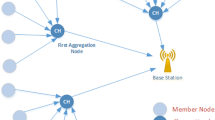Abstract
A fundamental challenge in the design of wireless sensor networks (WSNs) is to maximize their lifetime especially because they have a limited and non-exchangeable energy supply. One of the most important methods to prolong the lifetime of a WSN is data aggregation. Indeed, data aggregation reduces the number of broadcasts, hence collisions and energy consumption. Many methods has been proposed in the literatures to organize the network for data aggregation like clustering which has been proved to provide the best performance in term of energy saving, aggregation gain and packet delivery accuracy, or structure free which has been proved to perform better than a structure-based data gathering. To benefit all the advantages of these two approaches, we propose a hybrid method that combines multi-level structure-based approaches for time-constrained wireless sensor networks. Simulation results show that our proposed method can improve aggregation gain and energy consumption.





Similar content being viewed by others
References
Kwon S, Ko JH, Kim J, Kim C (2011) Dynamic timeout for data aggregation in wireless sensor networks. Computer Netw 55:650–664
Heinzelman W, Chandrakasan A, Balakrishnan H (2000) Energy-efficient communication protocol for wireless microsensor networks. In: System sciences, 2000. Proceedings of the 33rd Annual Hawaii International Conference on, vol 2, p 10. doi:10.1109/HICSS.2000.926982
Zhang J, Wu Q, Ren F, He T, Lin C (2010) Effective data aggregation supported by dynamic routing in wireless sensor networks. In: Communications (ICC), 2010 IEEE International Conference on, pp 1–6. doi:10.1109/ICC.2010.5502284
Yousefi H, Yeganeh MH, Alinaghipour N, Movaghar A (2012) Structure-free real-time data aggregation in wireless sensor networks. Comput Commun 35(9):1132–1140. doi:10.1016/j.comcom.2011.11.007
Fan KW, Liu S, Sinha P (2007) Structure-free data aggregation in sensor networks. IEEE Trans Mobile Comput 6(8):929–942. doi:10.1109/TMC.2007.1011
Loscri V, Morabito G, Marano S (2005) A two-levels hierarchy for low-energy adaptive clustering hierarchy (TL-LEACH). In: Vehicular Technology Conference, 2005. VTC-2005-Fall. 2005 IEEE 62nd, vol 3, pp 1809–1813. doi:10.1109/VETECF.2005.1558418
Ye M, Li C, Chen G, Wu J (2005) EECS: an energy efficient clustering scheme in wireless sensor networks. In: Performance, computing, and communications Conference, 2005. IPCCC 2005. 24th IEEE International, pp 535–540. doi:10.1109/PCCC.2005.1460630
Younis O, Fahmy S (2004) HEED: a hybrid, energy-efficient, distributed clustering approach for ad hoc sensor networks. Mobile Comput IEEE Trans 3(4):366–379. doi:10.1109/TMC.2004.41
Bandyopadhyay S, Coyle E (2003) Minimizing communication costs in hierarchically clustered networks of wireless sensors. In: Wireless communications and networking, 2003. WCNC 2003. 2003 IEEE, vol 2, pp 1274–1279. doi:10.1109/WCNC.2003.1200556
Jin Y, Wang L, Kim Y, Yang X (2008) EEMC: an energy-efficient multi-level clustering algorithm for large-scale wireless sensor networks. Computer Netw 52(3):542–562. doi:10.1016/j.comnet.2007.10.005
Madden S, Franklin MJ, Hellerstein JM, Hong W (2002) Tag: a tiny aggregation service for ad-hoc sensor networks. SIGOPS Oper Syst Rev 36(SI):131–146. doi:10.1145/844128.844142
Madden S, Szewczyk R, Franklin MJ, Culler D (2002) Supporting aggregate queries over ad-hoc wireless sensor networks. In: Proceedings of the Fourth IEEE Workshop on mobile computing systems and applications, WMCSA ’02, p 49. IEEE Computer Society, Washington, DC, USA. http://dl.acm.org/citation.cfm?id=832315.837554
Tan HO, Körpeoǧlu I (2003) Power efficient data gathering and aggregation in wireless sensor networks. SIGMOD Rec 32(4):66–71. doi:10.1145/959060.959072
Liu Q, Chang Y, Jia X (2013) A hybrid method of CSMA/CA and TDMA for real-time data aggregation in wireless sensor networks. Comput Commun 36(3):269–278. doi:10.1016/j.comcom.2012.09.016
Min X, Wei-ren S, Chang-jiang J, Ying Z (2010) Energy efficient clustering algorithm for maximizing lifetime of wireless sensor networks. AEU Int J Electron Commun 64:289–298. doi:10.1016/j.aeue.2009.01.004
Issariyakul T, Hossain E (2011) Introduction to network simulator NS2, 2nd edn. Springer, New York
NS-2: the network simulator. http://www.isi.edu/nsnam/ns/
Tmote sky data sheet. http://www.eecs.harvard.edu/~konrad/projects/shimmer/references/tmote-sky-datasheet.pdf
Hill J, Szewczyk R, Woo A, Hollar S, Culler D, Pister K (2000) System architecture directions for networked sensors. SIGPLAN Not 35(11):93–104. doi:10.1145/356989.356998
Author information
Authors and Affiliations
Corresponding author
Additional information
This work received a grant from Conseil Général et CCI de l’AIN.
Rights and permissions
About this article
Cite this article
Abid, B., Nguyen, T.T. & Seba, H. New data aggregation approach for time-constrained wireless sensor networks. J Supercomput 71, 1678–1693 (2015). https://doi.org/10.1007/s11227-014-1241-7
Published:
Issue Date:
DOI: https://doi.org/10.1007/s11227-014-1241-7




